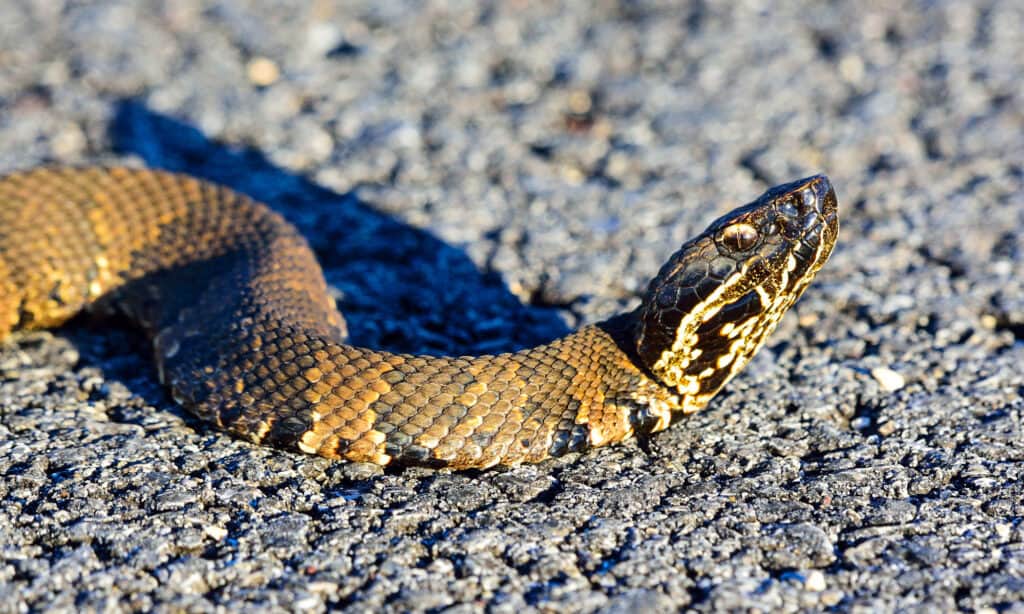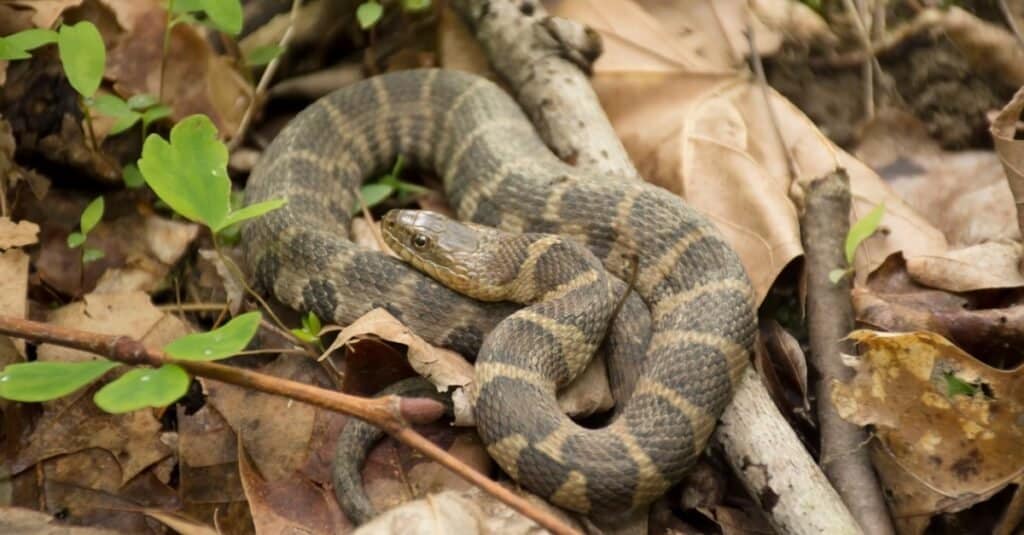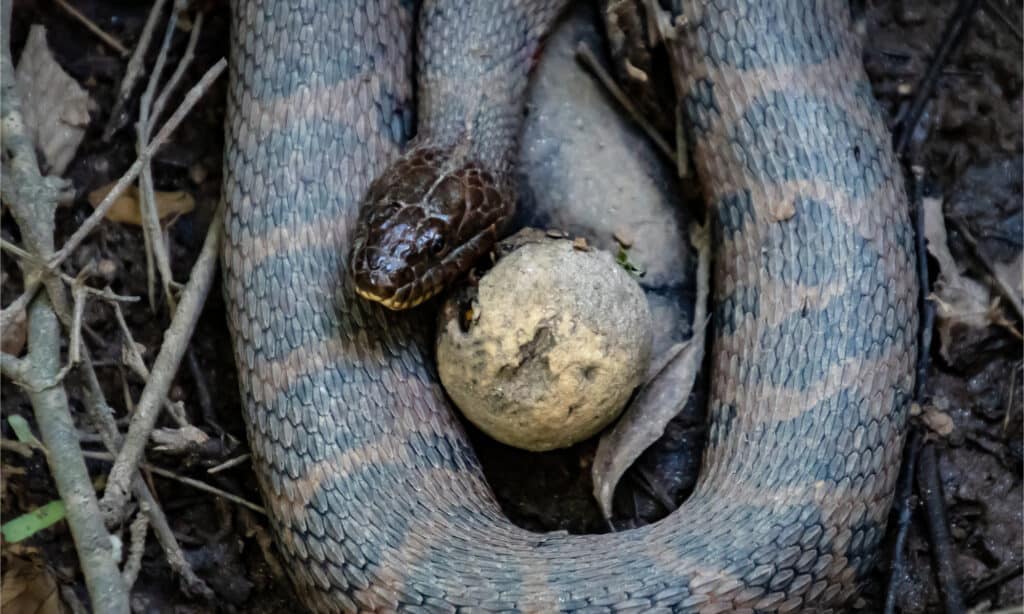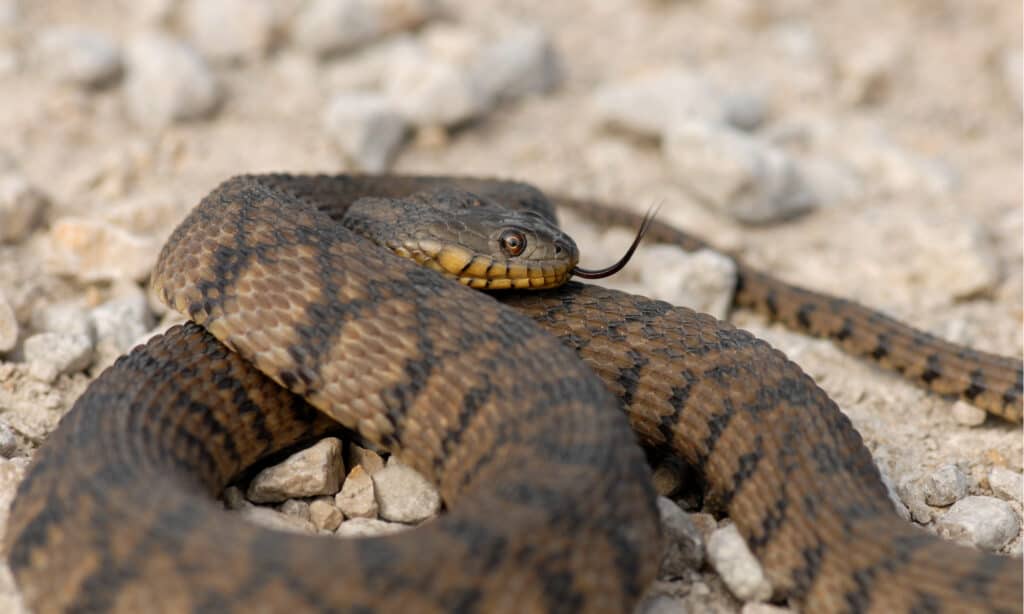Known as the Lone Star State, Texas spans a vast area and has a diverse range of habitats. Although it is home to many animals, snakes are especially common. There are approximately 96 species of snakes in Texas, of which 14 are venomous (including subspecies). One of these is the cottonmouth which is also one of the few aquatic pit vipers. So, let’s explore cottonmouths in Texas – including what they look like, what sort of venom they have, and just how dangerous they really are!
Identifying Cottonmouths

Cottonmouths are semi-aquatic snakes.
©Marcum Havens/Shutterstock.com
When it comes to cottonmouth snakes, most people think that there is only one species – and up until 2015, that was true. However, a former subspecies – the Florida cottonmouth – was reclassified as its own species, which is native to Florida and Georgia. The other two subspecies now make up one single species – the northern cottonmouth, which lives across much of the rest of the southeastern region of the US. The northern cottonmouth is native to Texas, although we’ll simply refer to it as “cottonmouth” from here on in this article.
Cottonmouths are semi-aquatic snakes which makes them earn the moniker “water moccasin”. The most noticeable feature of these snakes is their “cotton mouth” – a bright white lining inside their mouth that resembles cotton. This is typically exposed when they are trying to defend themselves by coiling their bodies and opening their mouth in an attempt to ward off predators.
Cottonmouths are large, heavy-bodied snakes that are usually between 30 and 43 inches long. They are dark colored with dark brown bodies and black crossbands. However, sometimes cottonmouths can be much darker – almost black – which means that their crossbands become almost impossible to see. Despite this, juveniles look much different – having a yellow tail and reddish-colored crossbands over a tan ground color.
Where do Cottonmouths Live in Texas?
As they are semi-aquatic, cottonmouths spend a lot of time in water and are rarely found away from it. Cottonmouths are found across the eastern half of Texas, where they can occur in lakes, rivers, lowland swamps, ditches, and salt marshes. However, they are particularly abundant around woodland ponds in Texas. They often hold their head up above the water while they are swimming while the rest of their body is barely touching the water, rather than being completely submerged.
Cottonmouths are nocturnal snakes and are most active between April and October. However, they can sometimes still be seen basking in the sun on warm winter afternoons.
Cottonmouths are ovoviviparous, which means that their eggs hatch inside their body and they then give birth to live young. The juveniles are born between August and October – just before brumation begins.
Cottonmouth Venom

The cottonmouth has cytotoxic venom.
©Ad Konings/Shutterstock.com
Although all most venomous snakes are dangerous, just how dangerous they depend on what type of venom they possess and how high their venom yield is. With cottonmouths, it’s important to remember that even juveniles are dangerous as they still contain venom and possess the fangs to inject it.
Most venomous snakes contain one of four types of venom – cytotoxic, neurotoxic, hemotoxic, and proteolytic. Cottonmouths have cytotoxic venom, which works by attacking tissue. In many cases, this type of venom causes tissue death (necrosis). Therefore, although cytotoxic venom isn’t necessarily always as fatal as some of the other types, it can still cause extensive scarring. In the worst cases, it can result in amputation of the affected limb.
Cottonmouths don’t just have dangerous venom, though – they also have a high venom yield too. Between 100 and 150mg of cottonmouth venom is estimated to be fatal to a human. Most cottonmouths inject an average of 125mg of venom in a single bite. However, in some cases, this can be as high as 237mg.
How Dangerous are Cottonmouths in Texas?
There are around 7,000 to 8,000 snake bites inflicted by venomous snakes in the US every year, which result in an average of five deaths. Across the entire US, cottonmouths cause only 1% of these. This means that statistically, they are not as dangerous as some of the other venomous snakes that you might come across. However, this figure does rise to 7.3% if we only consider the actual range of the cottonmouth.
Although Texas has a lot of snakes, very few people actually die from venomous snakes. On average, one or two people die per year in Texas, with there being no deaths at all in some years. Cottonmouths are reported to be responsible for 7% of all snake bites in Texas – which is on par with the figure above across their known range. However, the chances of you dying from one is still low.
What to Do if You are Bitten by a Cottonmouth?
The majority of all snake bites happen when the snake is accidentally stood on or disturbed. Cottonmouths can bite when they are in the water, so this is a danger with these snakes too. Although we’ve just established that cottonmouths are dangerous snakes and contain potent venom, studies suggest that around 50% of all cottonmouths prefer to flee when they are disturbed rather than attack.
The most important thing that you can do to avoid being bitten by any venomous snake is to tread carefully, be careful when stepping over rocks and logs, and watch where you put your hands. Never put your hand in a crevice or underneath a log, as you never know what could be lurking there.
If you do happen to see a cottonmouth, then the best thing to do is simply back away and leave it be. So long as you don’t threaten the snake or attempt to move it, the chances are it will simply flee and leave you alone. However, cottonmouths do tend to head back to the water when they are disturbed, so never stand between the snake and the water.
If you are bitten by a cottonmouth, then the symptom that you will experience are swelling of the affected area and intense burning pain. The most important thing you should do is seek medical help immediately. Most cottonmouth bites can be treated successfully with anti-venom, which needs to be administered within six hours of the bite. However, for the best results, it should be given within one hour. Additionally, cottonmouth bites can quickly get worse within a few hours. So, even if you don’t think the bite is serious, you should still get help immediately.
Similar Aquatic Snakes in Texas
As there are a lot of snakes in Texas, it’s probably not surprising that there are a few (harmless) snakes that look like them. Unfortunately, in many cases, these snakes are hunted, maimed, and even killed simply because they are mistaken for a cottonmouth. Therefore, we thought we’d give you a quick rundown of these snakes too.
Northern Water Snake (Nerodia sipedon)

The northern water snake has a flat head that is as wide as its neck.
©iStock.com/IcemanJ
The northern water snake is the snake that is most commonly misidentified as the cottonmouth. These snakes are 24 to 54 inches long and have brownish-black bodies with darker blotches on their bodies and crossbands on their neck. They are mainly found in the central region of the state in and around slow-moving water.
Southern Water Snake (Nerodia fasciata)

Southern water snakes have thick bodies.
©Deborah Ferrin/Shutterstock.com
Also known as the banded water snake, these snakes are greenish-gray to brown with dark brown to black crossbands. They can also be so dark that their markings are difficult to see. However, they can be distinguished from cottonmouths by the presence of a dark band extending from their eye to their jaw. Southern water snakes also have thick bodies and are 24 to 42 inches long. They are mainly found in the eastern third of the state.
Diamondback Water Snake (Nerodia rhombifer)

Diamondback water snakes are non-venomous.
©Rusty Dodson/Shutterstock.com
The final snake is the diamondback water snake which prefers wetland areas with overhanging vegetation. These snakes reach 30 to 48 inches and have brown bodies with black blotches that are connected by diagonal lines.
Up Next
- Discover the 10 Types of Rattlesnakes in Texas
- 96 Snakes Found in Texas (14 are Venomous!)
- Discover the Most Dangerous (Deadliest) Animals in Texas
The photo featured at the top of this post is © Ad Konings/Shutterstock.com
Discover the "Monster" Snake 5X Bigger than an Anaconda
Every day A-Z Animals sends out some of the most incredible facts in the world from our free newsletter. Want to discover the 10 most beautiful snakes in the world, a "snake island" where you're never more than 3 feet from danger, or a "monster" snake 5X larger than an anaconda? Then sign up right now and you'll start receiving our daily newsletter absolutely free.
Sources
- Texas Parks and Wildlife (1970) Known as the Lone Star State, Texas spans a vast area and has a diverse range of habitats. Although it is home to many animals snakes are particularly common. There are approximately 96 species of snakes in Texas of which 14 are venomous (including subspecies). One of these venomous snakes is the cottonmouth which is also one of the few aquatic pit vipers. So, let’s learn about cottonmouths in Texas - including what they look like, what sort of venom they have, and just how dangerous they really are! Identifying Cottonmouths When it comes to cottonmouth snakes most people think that there is only one species - and up until 2015 that was true. However, a former subspecies - the Florida cottonmouth - was reclassified as its own species which is native to Florida and Georgia. The other two subspecies now make up one single species - the northern cottonmouth which lives across much of the rest of the southeastern region of the US. The northern cottonmouth is the species that is native to Texas, although we’ll simply refer to it as “cottonmouth” from here on in this article. Cottonmouths are semi-aquatic snakes which is something that earns the the moniker “water moccasin”. The most noticeable feature of these snakes is their “cottonmouth” - a bright white lining inside their mouth which resembles cotton. This is typically exposed when they are trying to defend themselves by coiling their bodies and opening their mouth in an attempt to ward off predators. Cottonmouths are large, heavy-bodied snakes which are usually between 30 and 43 inches long. They are dark coloured with dark brown bodies and black crossbands. However, sometimes cottonmouths can be much darker - almost black - which means that their crossbands become almost impossible to see. Deapite this, juveniles look much different - having a yellow tail and reddish-coloured crossbands over a tan ground colour. Where do Cottonmouths Live in Texas? As they are semi-aquatic, cottonmouths spend a lot of time in water and are therefore rarely found away from it. Cottonmouths are found across the eastern half of Texas where they can occur in lakes, rivers, lowland swamps, ditches, and salt marshes. However, they are particularly abundant around woodland ponds in Texas. They often hold their head up above the water while they are swimming while the rest of their body is barely touching the water, rather than being completely submerged. Cottonmouths are nocturnal snakes and are most active between April and October. However, they can sometimes still be seen basking in the sun on warm winter afternoons. Cottonmouths are ovoviviparous which means that their eggs hatch inside their body and they then give birth to live young. The juveniles are born between August and October - just before brumation begins. Cottonmouth Venom Although all most venomous snakes are dangerous, just how dangerous they are depends on what type of venom they possess and how high their venom yield is. With cottonmouths it’s important to remember that even juveniles are dangerous as they still contain venom and possess the fangs to inject it with. Most venomous snakes contain one of four types of venom - cytotoxic, neurotoxic, hemotoxic, and proteolytic. Cottonmouths have cytotoxic venom which works by attacking tissue. In many cases this type of venom causes tissue death (necrosis). Therefore, although cytotoxic venom isn’t necessarily always as fatal as some of the other types it can still cause extensive scarring and in the worst cases it can result in amputation of the affected limb. Cottonmouths don’t just have dangerous venom though - they also have a high venom yield too. Between 100 and 150mg of cottonmouth venom is estimated to be fatal to a human. Most cottonmouths inject an average of 125mg of venom in a single bite. However, in some cases this can be as high as 237mg. How Dangerous are Cottonmouths in Texas? There are around 7,000 to 8,000 snake bites inflicted by venomous snakes in the US every year which result in an average of five deaths. Across the entire US cottonmouths cause only 1% of these which means that statistically they are not as dangerous as some of the other venomous snakes that you might come across. However, this figure does rise to 7.3% if we only consider the actual range of the cottonmouth. Although Texas has a lot of snakes in it very few people actually die from venomous snakes. On average one or two people die per year in Texas, with there being no deaths at all in some years. Cottonmouths are reported to be responsible for 7% of all snake bites in Texas - which is on par with the figure above across their known range - but statistically the chances of you dying from one is still low. What Should You Do if You See or are Bitten by a Cottonmouth? The majority of all snake bites happen when the snake is accidentally stood on or disturbed. Cottonmouths can bite when they are in the water, so this is a danger with these snakes too. Although we’ve just established that cottonmouths are dangerous snakes and contain potent venom, studies suggest that around 50% of all cottonmouths prefer to flee when the are disturbed rather than attack. The most important thing that you can do to avoid being bitten by any venomous snake is to tread carefully, be careful when stepping over rocks and logs, and watch where you put your hands. Never put your hand in a crevice or underneath a log as you never know what could be lurking there. If you do happen to see a cottonmouth then the best thing to do is simply back away and leave it be. So long as you don’t threaten the snake or attempt to move it the chances are it will simply flee and leave you alone. However, cottonmouths do tend to head back to the water when they are disturbed, so never stand between the snake and the water. If you are bitten by a cottonmouth then the symptom that you will experience are swelling of the affected area and an intense burning pain. The most important thing you should do is seek medical help immediately. Most cottonmouth bites can be treated successfully with anti-venom which needs to be administered within six hours of the bite. However, for the best results it should be given within one hour. Additionally, cottonmouth bites can quickly get worse within a few hours, so even if you don’t think the bite is serious you should still get help immediately. Similar Aquatic Snakes in Texas As there are a lot of snakes in Texas it’s probably not surprising that there are a few (harmless) snakes that look like them. Unfortunately, in many cases these snakes are hunted, maimed, and even killed simply because they are mistaken for a cottonmouth. Therefore, we thought we’d give you a quick run down of these snakes too. Northern Water Snake (Nerodia sipedon) The northern water snake is the snake that is most commonly misidentified as the cottonmouth. These snakes are 24 to 54 inches long and have brownish-black bodies with darker blotches on their bodies and crossbands on their neck They are mainly found in the central region of the state in and around slow-moving water. Southern Water Snake (Nerodia fasciata) Also known as the banded water snake, these snakes are greenish-gray to brown with dark brown to black crossbands. They can also be so dark that their markings are difficult to see, but they can be distinguished from cottonmouths by the presence of a dark band extending from their eye to their jaw. Southern water snakes also have thick bodies and are 24 to 42 inches long. They are mainly found in the eastern third of the state. Diamondback Water Snake (Nerodia rhombifer) The final snake is the diamondback water snake which prefers wetland areas with overhanging vegetation. These snakes reach 30 to 48 inches and have brown bodies with black blotches that are connected by diagonal lines. Up Next Sources https://tpwd.texas.gov/huntwild/wild/species/westerncottonmouth/
- Live Science, Available here: https://www.livescience.com/43597-facts-about-water-moccasin-cottonmouth-snakes.html#:~:text=%22Like%20all%20pit%20vipers%2C%20%5B,which%20is%20often%20potential%20prey
- Center for Disease Control and Prevention, Available here: https://www.cdc.gov/niosh/topics/snakes/default.html#:~:text=Each%20year%2C%20an%20estimated%207%2C000,than%20to%20die%20from%20them.
- National Library of Medicine, Available here: https://www.ncbi.nlm.nih.gov/books/NBK546645/
Thank you for reading! Have some feedback for us? Contact the AZ Animals editorial team.






